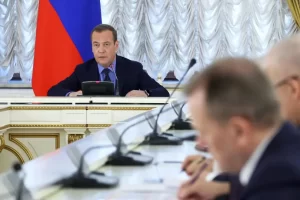Kansas economists predict modest growth and healthy tax revenues, with new estimates released Thursday adding $238 million over the next two years to state coffers.
The revenue forecasts come ahead of legislators and Gov. Laura Kelly finalizing budgets and tax cuts during the coming week. Politicians have a projected $1.9 billion budget surplus to work with for the current fiscal year, and a $2.5 billion surplus for next year.
“These revenue estimates show that Governor Kelly’s laser-sharp focus on growing the economy and landing new business deals is paying off,” said Brianna Johnson, a Kelly spokesperson, in a statement. “Now, Kansas can continue balancing its budget, fully funding schools, and passing responsible tax cuts — all while increasing funding for special education.
“However, it’s important to note that this is only an estimate of revenues for the next two years and doesn’t include the impacts of potential unforeseen events. Legislators must continue working together to pass commonsense, fiscally responsible policies that don’t throw the budget out of balance long-term.”
Kelly on Friday signed the state government’s $17.9 billion budget in House Bill 2184, with some line-item vetoes. But the more substantive or controversial spending decisions — like a pay raises for state employees to the tune of $80 million — have yet to be made.
Kelly’s administration is expected to unveil budget adjustment requests on Monday. Legislators still have the omnibus budget to work through and have yet to pass a K-12 public education budget. Meanwhile, hundreds of millions of dollars worth of tax cut proposals are up in the air.
Does Kansas budget surplus mean tax cuts plans are affordable?
House Speaker Dan Hawkins, R-Wichita, said the forecasts support the budget and tax cut bills.
“The legislature passed a tax plan that is both sustainable and provides tax relief for all Kansans,” Hawkins said in a statement. “The balanced budget Republicans sent to the Governor is sustainable as well while also strengthening the rainy-day-fund, making strategic investments in our state’s future, and eliminating wasteful overspending. The updated revenue estimate just makes both bills more of a no brainer.”
The budget projections have the fiscal year 2023 ending balance at more than $1.9 billion and before increasing to more than $3 billion at the end of the fiscal year 2024. Those budget forecasts include do include proposed tax cuts and spending changes, though the revenue projections do not include such considerations.
The $3 billion figure also does not include the base funding of $520 million for special education, according to the governor’s office, which if factored in reduces the 2024 surplus to a little more than $2.5 billion.
While Adam Proffitt, the governor’s budget director, acknowledged that large ending balances come from taxpayers, he discouraged focusing too much on the short-term surplus when enacting long-term tax cuts.
“To look at an ending balance at one point in time and assume you have enough money to cover expenditures five years from now is like looking at your bank account on payday and forgetting you have to pay your mortgage next month,” he said. “So the short answer is yes, there’s a point in time in which there needs to be money given back to the citizens, but making sure that you’re looking at money across time and obligations across time.”
Proffitt offered no insight into Kelly’s plans for a package of tax cuts headlined by a flat income tax proposal, declining to opine on whether the new revenue estimates suggest Senate Bill 169 is affordable. He emphasized that the governor’s administration is focused on ensuring ongoing revenues exceed ongoing expenditures.
“The governor has always been focused on looking across the horizon, ensuring that we have structural balance for years to come so we don’t find ourselves in a hole,” Proffitt said. “That’s not an answer directly to your question, but that’s philosophically where she has always been, and I would imagine will continue to be.”
Kansas forecasts include GDP growth, lower inflation, higher unemployment
The predictions for state revenues come from a consensus revenue estimating group of economists who base their estimates on economic forecasts. They factor in expectations like slowing inflation from pandemic highs, increased unemployment from pandemic lows, rising real GDP, mild fluctuations in oil and gas prices and production, rebounding demand for aircraft from Wichita’s aviation industry and rising commodity and input prices amid persistent drought for the state’s agriculture sector.
“Still feel good about where things are heading,” Proffitt said. “It’s nice to see inflation abating ever so slightly, although we’d like to see that come down a little bit more. Also good to see some some real GDP growth and not just nominal growth.”
J.G. Scott, the Kansas Legislative Research Department’s director, said the group is “pretty confident” in its estimates.
“Basically, when we were looking at this, we were thinking that the inflation dropping some and some modest real growth, those two combined to just some modest increases in receipts going forward,” Scott said.
The April revisions to the November estimates have state tax collectors bringing in an additional $75 million in taxes for the current fiscal year, which ends July 1, plus $53 million in other revenue. Next fiscal year’s estimates increased by $109 million, almost entirely due to tax collections.
Monthly tax receipts have consistently outpaced expectation before and after the November estimates, but officials said that is largely due to income tax shifts from the SALT Parity Act. That law allows certain pass-through entities to pay corporate taxes that are then credited to the income tax burden of the entity owners.
That has resulted in higher corporate income taxes over the winter, but Proffitt said that reflects “a little bit of artificial good news” as fiscal analysts expect a corresponding drop in personal income taxes this spring. Proffitt said the future offset will be about $40 million to $50 million.
Revenues are otherwise tracking fairly close to estimates. The new tax revenue projections for fiscal year 2023 reflect a 0.7% increase above November estimates, which Proffitt described as “margin of error type stuff relative to the last forecast.”
Source : CJ Online






































